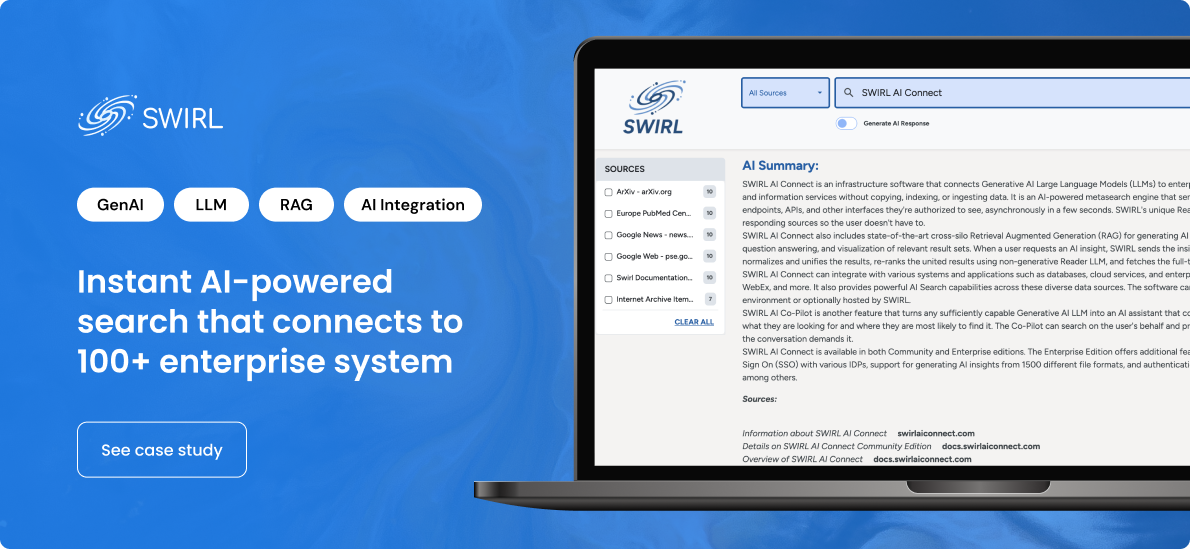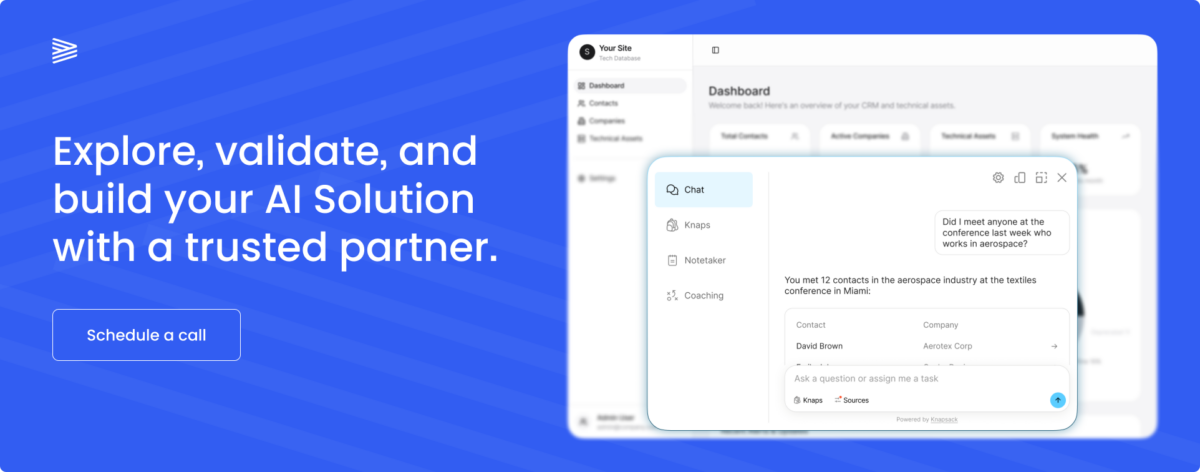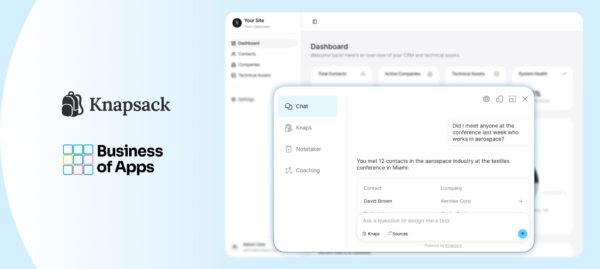Knapsack Chat: Simple, Secure AI Integration for SaaS
Cheesecake Labs | Oct 29, 2025

AI has officially entered the boardroom. Over 80% of organizations have started piloting this new class of enterprise technology, driving AI business use cases to an all-time high. Companies that recognize AI’s scale and potential injected $252.3 billion into the AI arms race last year — enough to fund 1,000 unicorn startups at $250 million each.
But knowing that AI is powerful is not the same as knowing how to use AI. A sobering 95% of projects — especially in sales and marketing — still show zero return.
That’s where many businesses get stuck: between potential and execution. How do you pick a starting point when everything sounds important?
In this post, we’re breaking down successful examples of AI deployments in different industries to showcase how businesses are using artificial intelligence and to give you some ideas worth testing!
AI applications are business tools that perform tasks usually handled by humans — often faster, more consistently, and at lower cost. They run on artificial intelligence — systems that replicate certain forms of human judgment, like identifying correlations in data, classifying information, and making predictions.
What makes AI applications distinct from traditional hard-coded software is that they rely on learned patterns (sometimes millions of examples) to get better over time. And because they don’t follow rigid logic trees, they’re more adaptable and can be fine-tuned to deliver exactly the functionality businesses need.
The mechanics vary, but most AI applications are built on a small set of technical foundations:
You’ve probably heard of Salesforce’s Einstein GPT and Microsoft 365 Copilot, among other high-profile artificial intelligence applications in business.
But not all AI tools are as visible as these flagship platforms. Some are smaller, tightly scoped systems built to solve one operational problem — but they’re incredibly effective because they’re plugged into the right place.
Let’s take a closer look at some of these successful real-world AI applications.
The applications of artificial intelligence now span every corner of the org chart.
Customers are more impatient than ever before. Not only do they expect accurate and personalized support — they want it instantly, across every channel.
Executives know it, too: according to IBM, 62% acknowledge that generative AI business applications are breaking old assumptions about how to design customer experiences. Those that deployed AI early are already reporting 38% faster call handling and 17% higher customer satisfaction.
Remember those annoying early-gen chatbots that simply read from a script and looped us around in circles? They’re gone.
New chatbots are using NLP and GenAI to understand intent and resolve requests, handing off to human agents only when escalation is clearly needed.
Scotiabank, for example, is now using Gemini and Vertex AI to power a smart banking assistant that can handle customer questions, suggest next steps, and learn from each interaction.
Alaska Airlines is also building an AI-powered, on-brand search experience that feels like you’re talking to one of their travel agents. The company hopes that it will help customers book their flights faster.
Generative AI and CRM integration is now allowing companies to analyze behavior in real time and tailor support to each customer’s situation — sometimes before they even ask.
IBM helped a German media company do exactly that by building a generative AI assistant that delivered personalized recommendations 10x faster, boosting customer satisfaction by 15%.
In the theme park space, Six Flags has built an industry-first digital assistant that can personalize ride recommendations and help guests plan their day around their individual preferences.
Human agents no longer have to waste time searching through knowledge bases or old tickets. AI assistant tools can almost instantly surface relevant information and even recommend solutions based on past cases — all within the helpdesk environment.
Bell Canada’s customizable contact center solutions are a good working blueprint for this new paradigm. It uses AI-powered agent assistants to handle incoming calls.
When a human agent takes over, its Agent Assist platform listens in to provide real-time suggestions and sentiment analysis. Altogether, these AI tools have delivered $20 million in savings across customer operations.
Have you ever followed up with a helpdesk just to explain the problem all over again because the agent has no idea what you said last time?
Those days may soon be over. AI can review past interactions and auto-generate summaries, so customer service reps can pick up right where the last exchange left off.
TIM Brasil now uses Google Cloud Gen AI to transcribe customer service calls and then classify, summarize, and pinpoint what the customer needs. Verizon also uses it to read and pull out action items from email chains.
NLP engines can decode and translate requests in real time to serve diverse customer bases, no matter what language they speak. IT consultancy Zoi was one of the early adopters. It uses Gemini in Google Workspace to simplify communication across its teams in 30+ countries.
Operations teams are under more pressure than ever to do more with less and stay agile through change. That’s why 94% of business leaders say that AI will be critical to their success in the next five years.
Robotic process automation (RPA) is increasingly taking on repetitive, rules-based tasks like data entry and invoice processing.
And it’s not just used in back-office finance or logistics — it’s starting to prove itself in healthcare, too. Amigo Intelligence (built on Google AI technologies) helps clinics automate patient intake, exam analysis, and routine communication, freeing up staff to focus on care instead of admin.
Overall, 64% of companies report productivity gains from RPA and intelligent project assistants. These tools also streamline design-to-delivery workflows in physical product development and automate QA in software engineering. Public healthcare systems like the UK’s NHS are adopting RPA as well, using it for tasks such as appointment scheduling and claims management.
Do frequent equipment breakdowns put your production goals out of reach by noon? AI can analyze sensor data and maintenance logs to flag early warning signs and prevent the failure altogether, extending the life of your assets and keeping your repair costs predictable.
The results are hard to ignore: one mining firm slashed unplanned downtime by 30%, gaining back precious production time each month across its sites.
ML models can analyze and incorporate weather, seasonality, and even consumer-driven variables, like social media sentiment, to reduce forecasting errors by 50% and cut inventory shortages by 65%.
No wonder European coffee company Tchibo uses Vertex AI and BigQuery to avoid empty shelves during peak periods, both for its brick-and-mortar shops and online store. German e-commerce giant OTTO also used Google’s TiDE model to improve forecasting by 30%.
If you have ever wanted to see a live feed of your supply chain — not just where shipments are but what’s threatening to disrupt them — AI makes that possible. It can adjust routes based on port delays and rebalance procurement plans in response to geopolitical events and supplier risks.
Digital freight forwarder Nowports uses it to spot volatile routes early and adjust its freight strategies.
Also read about: Blockchain in Supply Chain Management: Streamlining Operations
The AI systems we have trained can now train us, too! AI is now widely used to coach new hires and shorten onboarding.
It can even personalize training programs to an employee’s skill level and pace to make instruction more efficient in high-turnover industries. Call center provider Transcom — which uses Gemini to train its agents — has sped up customer research by 70%.
With 40% of new products failing, teams need to make better design and engineering decisions earlier in the development cycle.
Can AI help? Early results from AI for product development look promising. It’s been shown to shorten time to market by 5%, improve PM productivity by 40%, and even improve employee experience by 100%.
Love Cheetos? If they’re tasting especially satisfying lately, generative AI might be the reason.
PepsiCo is using AI to perfect this best-selling snack’s flavor and shape, and relies on AI agents to continuously monitor and adjust temperature and moisture during production.
This AI use case shows just how far gen AI has come in ideation and early testing. Companies now routinely use it to come up with new product concepts and nudge teams past creative blocks.
With personalization driving up to 40% more revenue, recommender logic is becoming a core part of the product experience. Netflix arguably sets the standard here — its AI analyzes viewing behavior so effectively that over 80% of total watch time now comes through its recommendation engine.
Drowning in endless trails of usage logs and market data? AI can spot trends and opportunities across massive datasets — NLP can extract structured insights from reviews, comments, and support tickets, while ML can detect hidden patterns. Use them well, and these insights can help you position your products better.
Italy’s largest bank, Intesa Sanpaolo, recognized that value early and leaned into it. It uses AI to give its analysts faster access to data, which they then use to protect the bank from risk and improve its financial products.
Thanks to AI and ML, rapid prototyping is no longer reserved just for well-funded projects. You can use AI to simulate product performance and run predictive usability before you roll up your sleeves and build.
This has sped up iteration cycles in both manufacturing and software development.
Czinger Vehicles used generative design, 3D printing, and AI workflows to build the famous Czinger 21C hypercar (and it got good reviews!).
On the deployment side, enterprise AI search company SWIRL partnered with Cheesecake Labs to break down data silos across platforms like Snowflake and Salesforce. They built secure integration pipelines and a natural language interface, cutting internal search time by 80% and speeding up decision-making.

Artificial intelligence is earning its keep in hospitals, trading floors, and factory floors — here are some key ways major industries are putting AI to work.
It won’t be long until AI becomes a full-fledged ally in frontline care. Models trained on thousands of scans now outperform doctors in detecting stroke-related brain injuries and can even estimate when a stroke occurred. They’re also helping emergency departments catch bone fractures that humans miss in up to 10% of cases.
That dream of predictive, pre-symptomatic care? It might be closer to clinical rollout than we think. Pharmaceutical giant AstraZeneca developed an AI system that uses data from over 500,000 people to predict disease risks years before symptoms appear.
After years of twiddling their thumbs because of data privacy concerns, the financial industry is finally warming up to AI.
JP Morgan Chase now uses it to validate payments and reduce false rejections by 20%. AI tools are analyzing more data points to build fuller borrower profiles and generate more accurate credit scores.
Fintech startups are making headway, too. Knapsack’s AI-powered transcription platform for financial advisors, which automates meeting summaries and compliance checks, has raised $20.8 million in funding so far.

Beyond the usual process automation and route optimization, warehouses have started using AI-powered cameras to monitor inventory and detect anomalies. They’re also deploying audio AI to listen for unusual machine noise and detect equipment strain or fatigue.
Ever notice a shirt drop a few dollars after you leave it in your cart? That’s AI sensing your indecision and nudging you to buy.
But it doesn’t stop there. AI also scans competitor pricing, reviews, and even local weather to adjust promotions on the fly. It can even predict what will sell next week and restock accordingly.
Many of today’s AI deployments simply respond to our prompts, but the next wave of generative AI will actually create on our behalf.
It’s becoming intelligent enough to handle tasks end-to-end and lifelike enough to mimic human voices and faces. A little unsettling? Maybe. But stronger privacy and synthetic safeguards should (hopefully) limit misuse.
We might be able to start delegating context-sensitive tasks to AI agents in the near future. Need to stitch together several flights to visit three countries within five days? Your agent will understand exactly what you need and do multi-platform bookings for you.
AI-generated videos are still a bit awkward and unnatural right now, but new tools like Runway, Synthesia, and Visla are promising much smoother motion and dynamic composition. Analysts predict that it may be hard to tell AI video from real footage by 2030 (that’s really soon).
Did you know that generative AI can now create synthetic data that mimics real-world patterns without exposing personal information? These datasets are statistically realistic but completely artificial, so they can be safely used to test and train models in privacy-sensitive fields, like banking and healthcare.
Amid growing public pushback over data privacy, regulators are taking a harder line on GDPR and HIPAA compliance. There’s also been more R&D activity in fully homomorphic encryption, which enables AI to run computations on encrypted data without ever decrypting it.
So now that we’ve seen all of these practical AI use cases for startups and established enterprises alike, how do you know what type of AI could be helpful in your business?
Many AI initiatives end up underused because they were poorly chosen or rushed into. If you’re serious about integrating AI into your business, you need to find use cases that work with the data you already have.
The best place to start is with a problem, not the model — one that’s measurable, recurring, and costly enough to matter.
Then ask: Could AI reasonably help fix this? Use structured decision questions to guide the choice:
These questions help determine whether the right solution is classical ML, GenAI, an agent-based system, or simply a rule-based approach.
Before investing, map potential use cases on:
It’s also important to look past short-term wins because even successful pilots don’t always scale well:

At Cheesecake Labs, our expert team can help you go from concept to launch, combining product strategy, UX/UI, and engineering with hands-on AI integration and development experience.
Whether you’re starting from scratch or adding AI to an existing system, we’ll work closely with you at every step. We start by identifying the right use case for your business, then design an intuitive interface and build a product that’s fast, secure, and structured for broader rollout.
The top 5 most promising applications of artificial intelligence are in healthcare, finance, customer service, retail, and manufacturing. In these sectors, AI helps automate tasks, predict trends, personalize experiences, and reduce human error.
AI is used in business for fraud detection, disease prediction, customer support, demand forecasting, supply chain risk analysis, and much more.
Start by identifying a repetitive, data-relevant problem. Make sure that your data is clean, align your teams, and work with AI experts like Cheesecake Labs to build a solution that fits your workflow.
AI can support your business by automating decisions, predicting outcomes, and personalizing services. Use cases vary by industry — from delivery optimization to content recommendations.
Talk to us about your idea, and let’s see how AI can help your business!

Senior Software Engineer at Cheesecake Labs, leading AI initiatives and building productivity-driven applications using Rust and TypeScript. She also heads the internal AI Guild, driving innovation across teams and projects.


